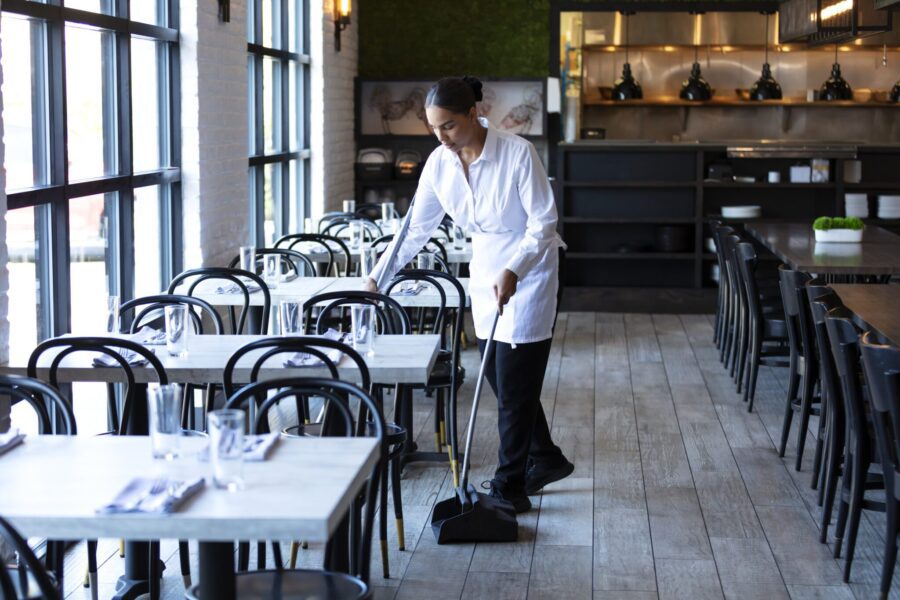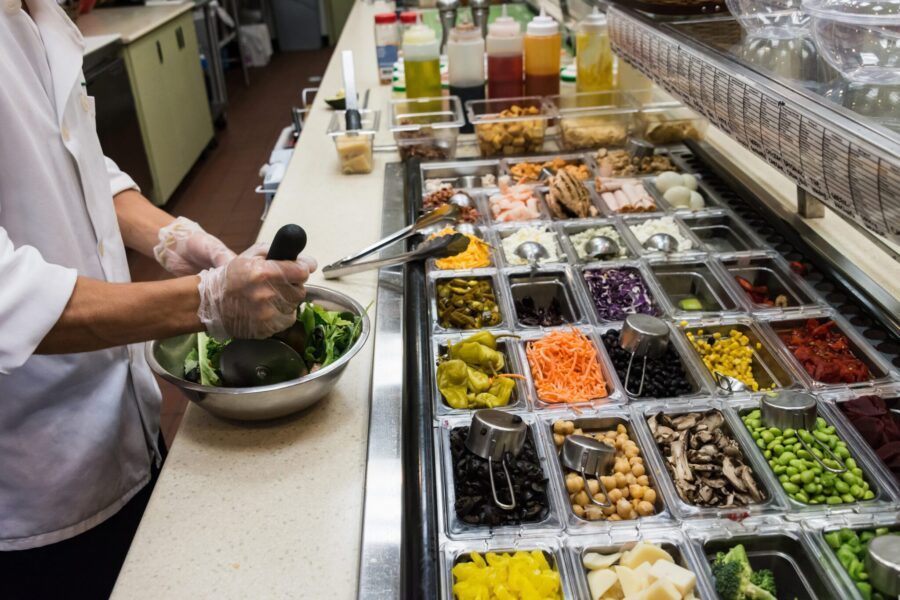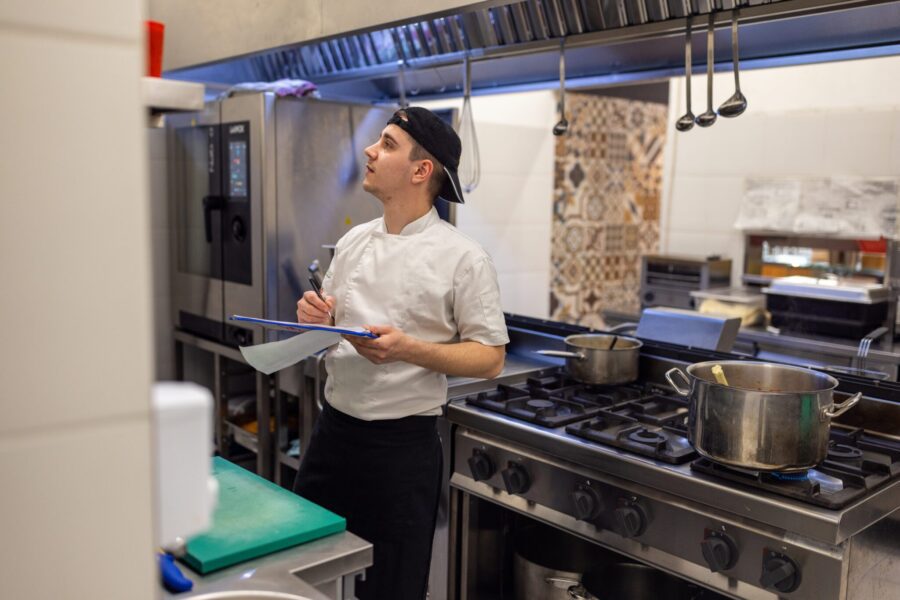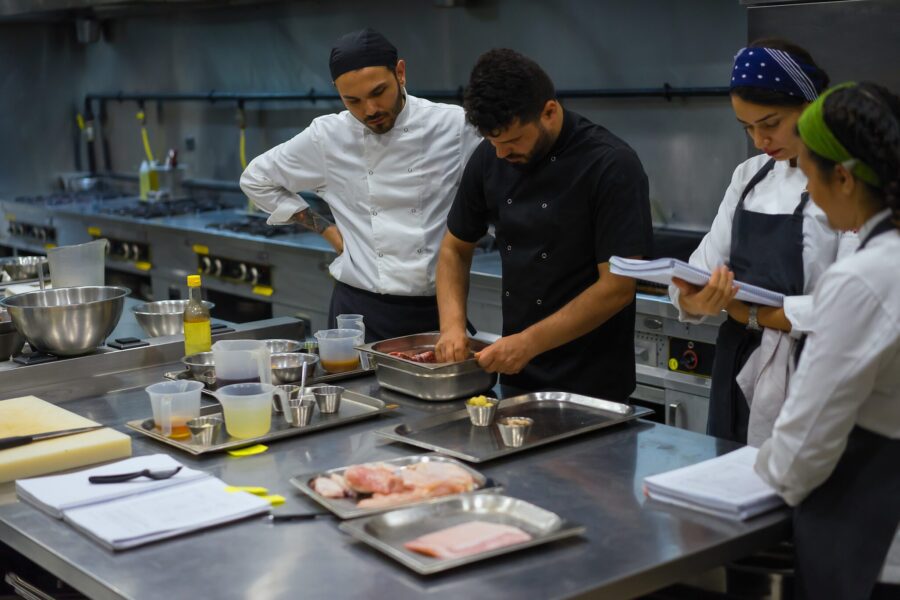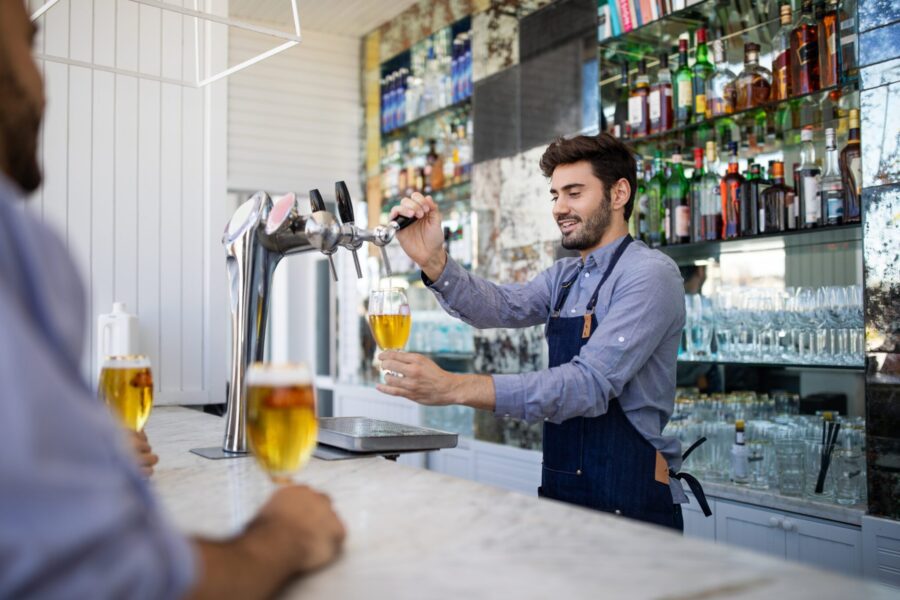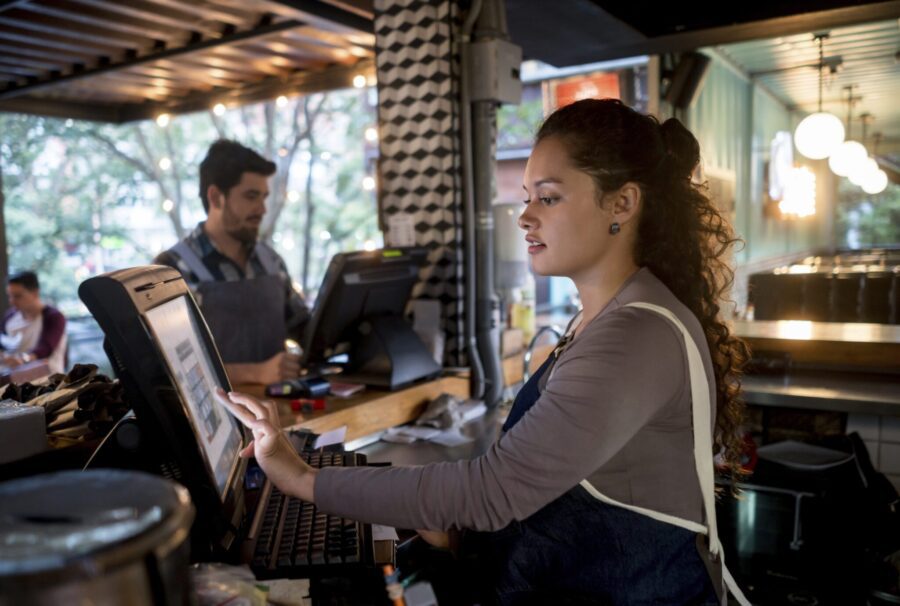Running a restaurant can bring a lifetime of both personal and financial rewards. It can also be a daily challenge, requiring an owner or manager to face many risks, some of which are unique to the restaurant business. Risks in the food and beverage industry can arise from food handling, equipment maintenance, regulatory compliance, worker safety, customer safety, alcohol consumption, property damage, reputation of the business, financial risks and more.
Restaurant Risk Management Planning, Policies and Procedures
To mitigate these risks, every restaurant owner and manager must develop a comprehensive risk management plan, based on policies that contribute to a team culture of risk awareness and executed through disciplined adherence to practical risk management procedures.
In this article, we’ll look at the most common risks facing restaurants, along with some proven techniques for managing those risks. We’ll also provide a basic outline for developing a restaurant risk management plan based on the unique risks facing any food business.
Food Handling Risks
Each year, as many as one in six Americans becomes ill from something he or she ate. Although most of these episodes are minor, over 3,000 people each year die from food poisoning. (Source: Centers for Disease Control and Prevention).
Some of the nation’s largest restaurant businesses have been hit with devastating human and financial consequences due to failures in safe food handling, including Taco Bell (E. Coli), Chipotle (Norovirus), Chi-Chi’s (Hepatitis A) and Jack in the Box (E. Coli).
While the safety of customers and staff are the most important reasons to emphasize safe food handling, the consequences of failure could also result in financial harm, including damages for liability, fines and loss of reputation that could bankrupt the business.
Food Handling Risk Management Plan
- Identify Food Safety Risks – Every item on a menu presents a unique food safety risk. Meat must reach temperatures sufficient to kill bacteria. Salads can easily be cross-contaminated. Study each food prep and service process for exposure to food handling risks.
- Monitor Food Quality – Compare suppliers for process safety. Observe deliveries to monitor their condition and production dates. Check food stocks to identify and discard suspect ingredients or slow-moving inventory.
- Train Staff for Food Handling – Make sure that all cooks, servers and helpers understand the principles of employee hygiene and food handling safety, including clean food preparation areas, clean equipment, clean cooking vessels, clean kitchen tools, and when necessary, gloves.
- Reinforce Food Safety Procedures – Conduct refresher training and post signs to remind staff that the knife they used to cut raw chicken is not to be used to make salad. Remind chefs to avoid undercooking. Post signs in break areas to reinforce the importance of employee hygiene.
- Follow Local Health Department Regulations – Comply with all local health department regulations and keep refrigeration, cooking, and washing equipment up to codes. Seek health department guidance on properly document food safety practices.
Equipment Risks
Many restaurant risks arise from poor equipment maintenance. Whether the purpose of the equipment is food storage, cooking or cleaning, a breakdown can result in a financial loss or can put your customers and staff at risk.
A refrigerator or freezer that is not cooling properly can ruin costly inventory through food spoilage, or it can cause a food borne illness. Any range, oven, fryer, toaster, steam table, heat lamp or other equipment that produces heat can malfunction and start a fire.
HVAC, water heating and other building systems are also potential sources of fire. Beyond fire risk, a malfunctioning range, oven or fryer could directly injure a worker, as could other types of powerful kitchen equipment, such as a grinder, mixer, slicer or washer.
Equipment Risk Management Plan
- Keep Equipment Clean – Cooking oil, grease and food can obstruct vents, foul screens and otherwise interfere with the proper equipment function. Food residue is also fuel for dangerous bacteria. Clean all kitchen equipment every 24 hours.
- Ensure Proper Maintenance – Most restaurant equipment has components that must be checked and cleaned, especially refrigeration and ventilation equipment, sink drains, dishwasher screens and waste line grease traps.
- Ensure Proper Training – Have operators studied the manual? Make sure that the appropriate equipment for the task is being used and that recommended startup, operating and shutdown procedures are being followed. Never allow safety guards to be disabled to make tasks more convenient.
- Schedule Regular Inspections – Equipment inspections are an important part of a manager’s duty to safeguard important assets of the business. For equipment that would be difficult to repair, consider extra protection with breakdown insurance.
- Get Expert Advice – At reasonable intervals, essential equipment should be inspected by a factory-trained expert who can provide an assessment of the equipment’s condition and make recommendations for any timely service, upgrade or replacement.
- Include Vehicles – If the restaurant operates vehicles, all of the foregoing advice applies equally to cars or trucks used for delivery or catering business. This is especially true for operators of food trucks, where the vehicle is the restaurant.
Regulatory Compliance Risks
Restaurants are subject to health and safety standards, labor laws, building codes and other laws and regulations. Failure to comply with these rules can result in fines or lawsuits, risking the financial well-being or the reputation of the business.
Regulations can vary by location, but they typically cover formal inspections of compliance with worker hygiene, food preparation and safety equipment codes.
Compliance with health codes is especially important because one violation can damage a restaurant’s reputation, and repeated violations can result in the restaurant being shut down.
Code compliance also helps protect a restaurant owner or manager from being sued, should a worker or customer become sick or suffer an injury.
Regulatory Compliance Risk Management Plan
- Obtain Required Licenses – Don’t operate without a business license, a food service license and a liquor license. A first inspection may be required before opening for food service. Certify any staff who will serve alcohol. A delivery driver may need a commercial license or supplementary commercial insurance.
- Learn Health and Safety Codes – Try to ace every health and safety inspection on the first pass. The laws are in place for the well-being of customers and workers and to protect the restaurant property through safe operating procedures.
- Observe Labor Laws – Labor laws protect workers from discrimination, workplace harassment and wrongful practices. Violations can be costly, so be certain that restaurant hiring, scheduling and compensation practices are lawful.
- Maintain Fire Safety Equipment – Local and OSHA fire safety codes regulate the accessibility of occupational health and safety, the number and location of fire exits, the types of extinguishers a restaurant must maintain and where fire-fighting equipment must be kept relative to cooking equipment.
- Prioritize Food Safety – For the protection of customers and workers, and to avoid the risk and cost of code violations, make food safety the #1 priority in training the team and managing kitchen and food service operations.
Workplace Safety Risks
Good service is quick service, so many workers in the restaurant industry are expected to hustle. As a result of this fast pace, restaurants can be dangerous places to work, at least in terms of minor injuries. For kitchen staff, the most common injuries are cuts and burns. For servers, the most common injuries are the result of slips, trips and falls.
Bureau of Labor Statistics data shows that restaurant workers are more than three times as likely as other workers to receive a cut serious enough to miss work, and they are almost 10 times as likely to miss work because of a burn injury.
Other common restaurant hazards include injuries from broken dishes and glassware, machines like mixers and blenders, spills of hot food or coffee and repetitive motion. A less common, but more serious, source of restaurant workplace injuries are kitchen and electrical fires.
Workplace Safety Risk Management Plan
- Keep Knives Sharp – It may not seem logical, but a sharp knife is much safer than a dull knife. A dull blade requires more force, sometimes causing a cut or laceration. A sharp knife does the work with less motion and lighter pressure.
- Train for Range and Oven Safety – Kitchen workers must be trained to align pot handles, use oven mitts and warn co-workers when they are carrying a hot pan. Train staff to be careful around range tops, fryers, oven racks, pots and pans, hot implements and hot liquids.
- Safe Floors and Shoes – Slips, trips and falls are among the most common workplace injuries. Servers walk up to 10 miles a day, so keep floors clean and require all kitchen and wait staff to wear slip-resistant shoes that are safe on wet or greasy floors.
- Avoid Repetitive Motion Injury – Study kitchen processes to identify risks for repetitive motion injury, such as chopping and whipping. Use cushioned floor mats to avoid joint and back injuries. Recommend compression socks for leg pain. Train kitchen staff and servers to use stretching and exercise to avoid muscle strain.
Customer Safety Risks
An effective risk management strategy must reflect the unique role of the customer in a restaurant. Customers are not likely to suffer a burn in the kitchen, but they are definitely at risk from food poisoning, a slip and fall accident or a cut from broken glassware.
Customers are also at risk from the hazards common to any business structure, such as a slipping on icy stairs, tripping over an obstruction or injury during a storm or fire. Whenever a customer is on the property of the restaurant, there are risks that can result in losses.
While it is possible to train workers for safety awareness, there is no way to train customers. However, it is still possible to enhance customer safety in a variety of ways.
Customer Safety Risk Management Plan
- Emphasize Food Safety – The first rule of restaurant risk management is to keep the kitchen clean. To avoid food-borne illness, storage and prep areas should be continuously cleaned during the day or evening, even while kitchen staff are working.
- Keep Dining Rooms Clean – Floors must be free of grease or food spills that could cause a slip and fall. Clean up water on the restroom floor. Check to confirm that food packaging and other clutter are kept away from customer traffic areas.
- Prevent Equipment Breakdowns – Keep up PM to ensure that freezers and refrigerators are cold enough to keep food safe, beverage dispensers are sanitary and dishwashers are hot enough to keep dishes and cookware clean.
- Secure the Structure – Replace old wiring. Look for loose carpet that could cause a trip and fall. Don’t store heavy objects on shelves. Keep hallways clear, especially near fire exits. Check steps and railings for security. In winter, keep the sidewalk and entrance free of ice.
- Comply with Health and Safety Codes – When a customer is injured, the restaurant is less exposed to liability if its structure and operations are in compliance with health and safety codes. General liability insurance may refuse to pay for a loss that was caused by a code violation.
Alcohol Consumption Risks
The risks of serving alcohol in a restaurant primarily arise from incidents where a minor has been unlawfully served or a customer of legal age has been over-served. While liability law recognizes the burden on the customer to drink responsibly, the law can also hold the restaurant responsible for the safety of the customer while on the premises of the business, or after leaving the premises.
For example, if an intoxicated customer left the restaurant and caused a fatal vehicle crash, the family of the crash victim might sue the restaurant. Or if an over-served patron attacked another customer in the parking lot, the victim of the attack might successfully sue the restaurant for negligence.
The laws governing alcohol service, sometimes referred to as “dram shop” laws, can vary widely by state. In Texas, for example, a bartender may not be liable for over-serving a customer unless he or she is an owner or officer of the business. Nevertheless, it is essential for restaurant owners and managers to know their local laws and train their staff to handle alcohol service accordingly.
Alcohol Consumption Risk Management Plan
- Know the Liquor Laws – Every state governs the sale of alcohol and specifies the rules for consumption of alcohol on restaurant premises. These laws also regulate who may serve alcoholic beverages and under what circumstances a bar or restaurant may be held liable for negligence.
- Confirm that Servers are Qualified – Many states encourage restaurants to complete a responsible vendor program, combining manager and employee training with commitments to avoid controlled substances, educate patrons and manage customer consumption.
- Train Servers to Evaluate Customers – When a restaurant has required servers to complete TIPS or other intervention training in order to serve alcoholic beverages, the business can show that they have made reasonable efforts to recognize intoxication and avoid negligence, potentially earning insurance discounts.
- Evaluate the Level of Risk – Every restaurant is different. Some offer only beer or wine with dinner. Others offer distilled spirits or promote holiday parties to attract customers. Know the level of risk, and balance that risk with effective mitigation.
- Review Liability Coverage – What is the actual risk of unintentionally serving a minor? When a patron is intoxicated, what must a server do to establish reasonable effort? Restaurant owners and managers should meet with their insurer to understand the limits of liability and coverage.
Property Damage Risks
Restaurants must manage many of the same risks faced by homeowners and managers of other businesses, including fire, flood and storm damage. In addition, restaurants are challenged by unique risks, such as the continual presence of open flames for cooking and abundance of flammable material, such as wood furniture and linens.
Restaurants also have unusual ventilation, HVAC and electrical systems that can be a fire hazard in older buildings. Finally, with customer restrooms and hard-working sinks and dishwashers, restaurants are more vulnerable to sewer backups and water damage from plumbing and equipment breakdowns.
Property Damage Risk Management Plan
- Practice Prevention – Fire needs heat and fuel, so fire prevention Step 1 is ensuring that kitchen equipment and electrical systems are in good repair. Step 2 is keeping flammable materials and liquids away from heat sources. If possible, invest in a fire suppression system.
- Maintain Kitchen Equipment – Fire and water damage are often caused by equipment breakdowns. Keep refrigerator and freezer fans unobstructed. Keep ventilation ducts and fans free of dust and lint. Replace old equipment with questionable motors or wiring.
- Train for Fire Safety – Train all employees to observe fire codes and to know how to respond to a fire, call the fire department and guide customers to safety. Post signs as reminders, and conduct drills to confirm that training has been effective.
- Check for Leaks or Clogs – Kitchens use water for cooking, cleaning and washing dishes. Customers use the restrooms. Both are potential sources of a water leak, blocked drain or sewer backup that could cause water damage. Check plumbing daily to spot potential problems.
- Review Property Coverage – Is coverage suitable for the current costs of making repairs and replacing equipment and inventory? Restaurant owners and managers should meet annually with their insurer to review property coverage and make any necessary adjustments.
Financial Risks
Restaurants face unique financial risks. They welcome a new group of customers each hour of the day, and they may have a high turnover of staff. Restaurant employees must handle meal receipts, and it can be difficult to restrict access to open cash registers, cash tips or costly inventories, such as alcohol.
Employees also have opportunities for supplier fraud, mismanagement of funds or outright theft, any of which could lead to substantial financial losses.
Because most meal checks and bar tabs are paid with credit cards, restaurants are vulnerable targets for cybercriminals.
Finally, the market volatility of the food business is well-known. Changing customer preferences provide opportunities for newcomers but will also take market share from established restaurants.
Financial Risk Management Plan
- Keep Cash Secure – Implement practical cash handling procedures to prevent theft. Train employees to know how to handle cash, access cash registers and anticipate register audits.
- Use Point-of-Sale Data – Even low-cost POS systems will pay for themselves many times over with accurate documentation of every transaction, sales tracking, inventory management and financial reports to help the owner or manager make better financial decisions.
- Safeguard Customer Data – By storing customer data, a restaurant can take orders and deliver much faster, but credit card numbers and billing addresses are prime targets cyber theft. Use network passwords, and update anti-virus tools to guard against phishing and malware attacks. Consider cyber insurance, which can help with the cost of customer notification, monitoring and litigation.
- Document With Video – Video recording can prevent internal theft, document the behavior of an intoxicated patron or help police solve an act of arson or vandalism. The mere presence of cameras can deter criminal activity, and video evidence is often a shield against false claims.
- Anticipate Closures – There is nothing more devastating to a restaurant’s business than a forced closure, whether due to a viral pandemic, a hurricane or a single-site hazard such as a building fire. Whenever possible, it is prudent to set aside funds for an unexpected closure and to also consider carrying loss of business insurance.
Reputation Risks
In the restaurant business, an enduring reputation for quality and service is the single most valuable intangible asset. Hungry diners have unlimited options and choose their destinations based on preferences that are acquired through a history of positive experiences.
In the past, an owner or manager could guard the reputation of the business from within the restaurant, monitoring food quality, guiding the staff to deliver great service and responding to the occasional failure by overwhelming the customer with gracious apologies and free food or drink.
Today, however, it is just as important to manage the restaurant’s Google listing to avoid negative publicity by responding to reviews and to keep up a presence on social media. While one bad review is a small risk to a restaurant’s reputation, a series of bad reviews can be fatal.
Reputation Risk Management Plan
- Train for Reputation – Servers must understand that a good review tomorrow is more important than any single transaction today. Even when the customer is dead wrong, a server ready to hear the complaint and acknowledge the dissatisfaction may prevent a bad review.
- Manage Customer Expectations – Saying “Careful, these plates are hot!” is better than burning a customer’s hand, and warning every customer that the Thai sauce contains peanuts is better than getting a bad review (or a lawsuit) from a customer suffering food allergies.
- Empower Servers – Beyond showing staff how to handle an upset customer, go further and empower them to solve the problem on the spot. “I’ll go get the manager” is not as effective as “I’m sorry, I’ll remove that from your bill. Could I bring you a glass of wine or a nice dessert as our apology?”
- Get On-Site Reviews – One of the best ways to guard the reputation of a restaurant business is to ask for instant reviews. Managers should stop at each table and simply ask whether everyone is enjoying their meal. Train servers to ask again when the bill is presented.
- Manage On-Line Reviews – When a bad review happens, the correct response is: (1) thank the reviewer for the feedback; (2) apologize without equivocation; (3) mention their name and the issue; and (4) offer to make it right. Whether the reviewer accepts or not, other readers will put a high value on the sympathetic attitude and the generosity of the offer.
Restaurant Risk Management Checklist
Every restaurant and food business is different. Outlined below are the steps a manager can follow to develop solid restaurant risk management strategies for any business.
- Identify the Risks – Use the foregoing categories to identify all risks associated with a specific business. Consider food safety, equipment, compliance, worker safety, customer safety, alcohol consumption, property damage, financial risks and reputation of the business.
- Assess the Severity of Risks – Take the time to rank each potential risk from the greatest to the least. A restaurant owner or manager is the best judge of the operation, and a ranking of risks will make it possible to focus time and investment where it will have the most impact.
- Develop Mitigation Strategies – Using the examples given in this article, develop mitigation strategies that recognize the who, where and how of a real-world restaurant staff, location and operation.
- Establish Procedures – Next, turn strategies into tactics. Exactly how will we prevent cross-contamination in food preparation? How does the prep staff do it today? What should they change to make food handling safer? How can management guide and support them?
- Train Staff – Use written procedures, how-to graphics and reminder signs to raise risk management awareness. Make the entire staff partners in a culture of risk management, looking out for the safety of the team and the protection of the business through risk prevention.
- Monitor and Review – Risks evolve, so sustained risk management requires vigilance. Managers must regularly review the risk management plan and monitor staff compliance to improve procedures and make necessary adjustments.
